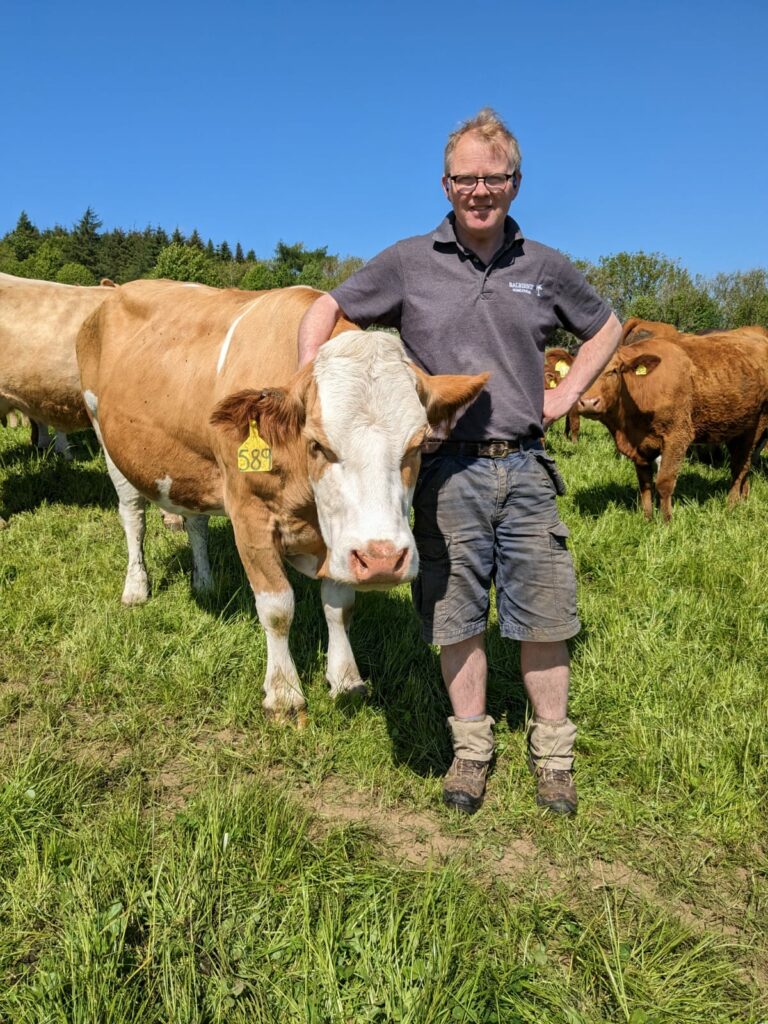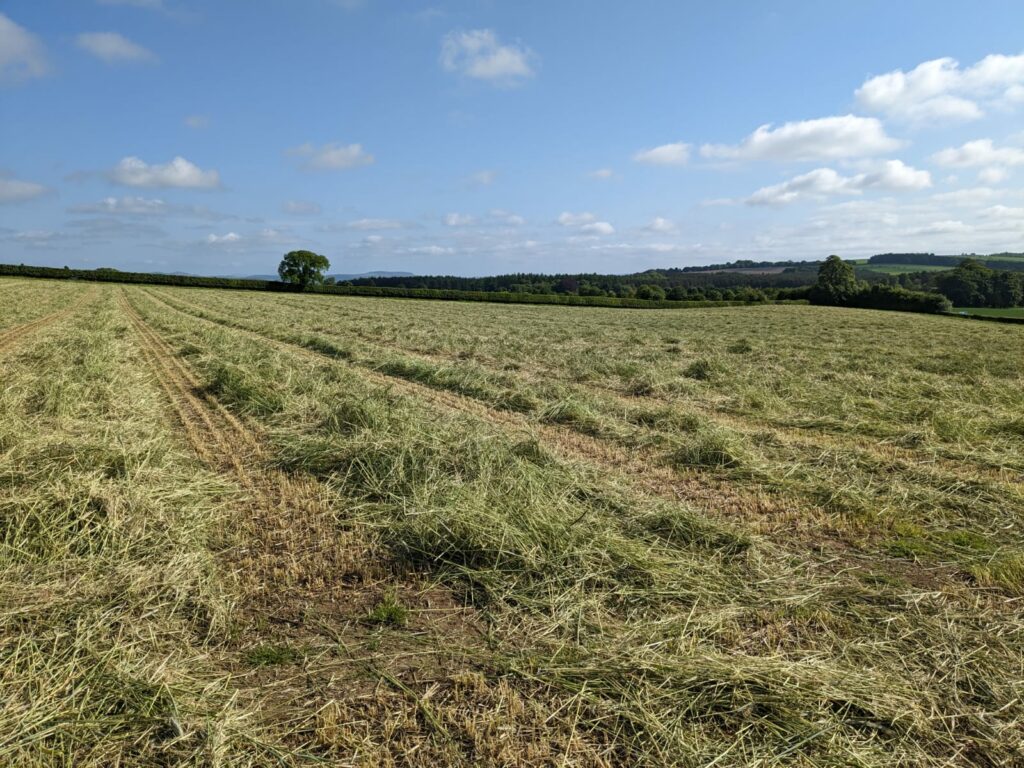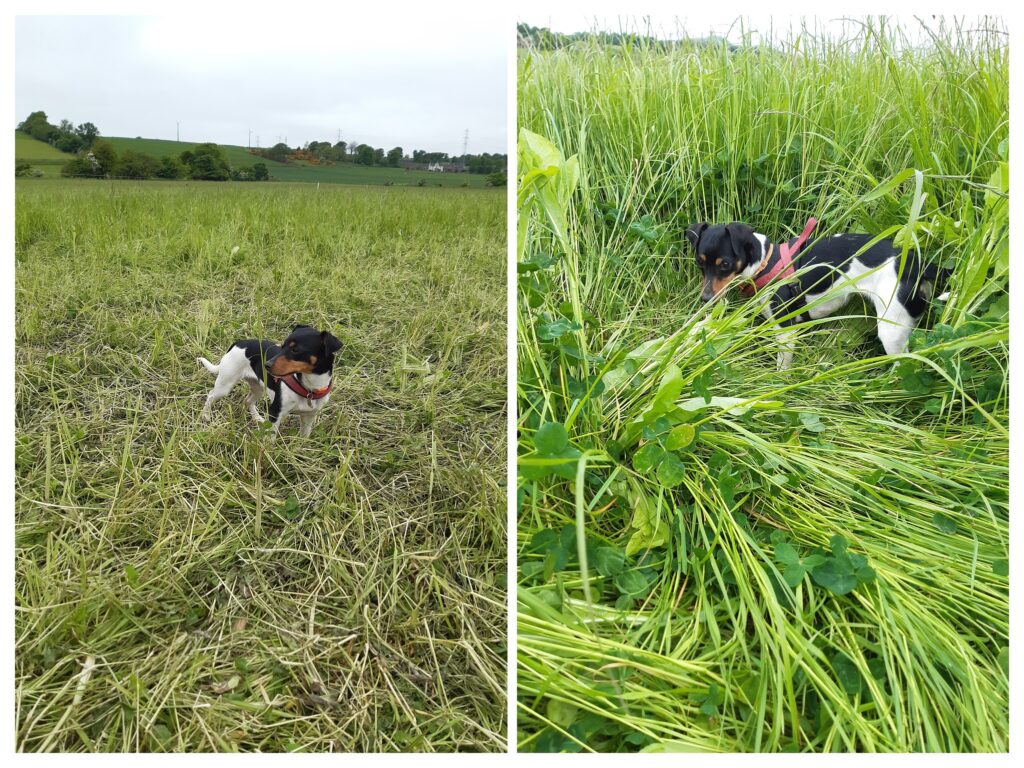Written 1st June 2023
Trials and learnings of livestock integration at BHF.
So, calving happened, with a few more issues than we expected. Through our breeding choices we have managed to significantly reduce the level of human intervention at calving over the last 5 years. However, we hit a small bump in the road this year with a handful of caesarians required for larger calves out of heifers. As we breed our own replacements, we perhaps need to look a bit further back in the cow’s genetics to weed out these niggles. The same bulls produced many more calves that were small and calved without issue.
We managed to turn calved cows out onto cover crops of rye within a few days of calving. This massively reduced our silage requirement as well as reducing the potential unhealthy issues that build up in a calving shed pre turn out. As well as saving money, the cows milk well on the rye, and this allows the use of the field up until work for the next crop is required, another part of our livestock/arable integration. We plan to calve outside next year, slightly later than we have done inside. When successful, we should no longer have the need to house cattle at all. This has been a goal for a few years now, so fingers crossed.
Spring sowing was completed, eventually. We seemed to wait through the eternity that was the wet month of March. I find lots of rain nerve-wracking at that time of the year, we know the clock is ticking on spring crop yield potential, and we know that every wet day requires a few more dry days before sowing will start. As ever though, the rain did take a break, we managed to start sowing barley on the 4th of April. This was followed by a few stops and starts until conditions settled about a week later, allowing rapid progress to be made. We had to be more patient with cultivated land than with no tilled ground. The improving soil structure allowed sowing to progress at a faster pace. This is the first time we have seen this happen, demonstrating clearly that soil structure improvements take time and patience.

One of the challenges we have been trying to overcome has been the fickleness of no-till spring barley. We have had many issues over the years with this scenario. Indeed, this challenge forms one of the trials that we are conducting as part of the AHDB Strategic Farm project. We hope to succeed in this respect after 6 years of trials. Whilst not directly part of the trial at the moment, this will change for next year, I have always thought that sheep might be a solution to this tricky no-till crop. So last winter we made a point of grazing down all the cover crops prior to barley that was due to be direct drilled. We grazed the covers down leaving varying degrees of residue behind. As crops look currently, this appears to have helped hugely. Barley sown into fields where the cover crops were eaten right down have established very strongly and will give any conventionally established crop a run for its money in my view. Where we left even a small amount of residue, crop vigour after emergence has not been too good. More residue tended to be left behind the store lambs as they required a higher plain of nutrition for growth, so were moved over fields faster to maintain growth. The ewes on the other can still thrive when left to eat covers right down. So, I think we will prioritise the use of breeding ewes to recycle the cover crop before spring barley in the future. It is amazing just how little residue can upset the growth of a young spring barley plant.
We have had time to digest and analyse the findings from grazing winter cereals with sheep. In mid-May we had a rather colourful outbreak of yellow rust in the only wheat field that we did not graze over the winter. All the surrounding fields were grazed and remained unaffected. Whilst not scientific, or validated by statistically significant plot trials, this observation alone is enough to make winter cereal grazing a planned part of the system every year. I think we can be a bit bolder too, eating the cereals down more in a short period, they will still bounce back quickly with fresh clean growth.

Cattle are all busily munching through grass that is up to their bellies. Grass growth was steady and manageable until mid-May, the weather warmed up over a weekend and everything has gone into overdrive since. The power of nature to catch up amazes me every season. However, conditions are drying rapidly now, and we are starting to think that grass growth is slowing in some fields already. As the dry spell continues, we will have to consider how much residue we leave behind the cows in order to keep some ground cover for moisture preservation reasons.
We are moving the mobs daily at the moment, under the principle that fast grass growth requires a fast-grazing rotation, 21 to 30 days. As the growth slows, we will lengthen the rotation, by grazing smaller areas each day to increase the rest period between grazings, this should allow full recovery of the pasture prior to the next grazing. The difficulty I find is confidently deciding when the growth has actually slowed down. This normally takes the form of a week of thinking about slowing the grazing down, before realising that we need to slow down now, or actually, a week ago. Alternatively, I can go and consult our tame cow, Hazel, to see what she thinks. Whilst she won’t give me the answer, she does serve as a calming influence on a really stressful day. Five minutes with her, and you’re ready to tackle the world again. Even the children enjoy her company.
Whilst we are pondering over our current grass growth, thoughts and actions are moving ahead to this coming winter. I mentioned in my last article that we grow kale for winter grazing. The kale crop dovetails neatly onto the back of an over wintered cover crop of rye and vetch. We let the cover crop grow until a suitable weather window in May (other technical timing descriptions do exist!). We mow the mixture for baling and wrapping. The bales are then lined up across the field to accompany the kale crop that is strip grazed. The kale is then direct drilled into the stubble, and all bar some fertilizer, weed control and a fair amount of pigeon patrol for the first few weeks, that’s the winter feed all set up. This provides a diet that the cows are content and thrive on. The aim is to grow all the winter feed on the fields where it will be eaten. This has reduced the costs hugely, particularly the machinery costs associated with harvesting, carting and feeding the cows during the winter months.

We have had issues with weaned calves not being keen to eat the rye silage and have stepped back to giving them grass silage with the kale. Last winter, we decided to leave the calves on their mothers for 8 weeks more than usual. This meant the calves were on kale with cows eating rye before weaning. The result was the calves learning to eat the rye silage. After weaning, they happily ate the same diet for the remainder of the winter. In hindsight, it is obvious that a calf should learn such things from its mother.
Our next challenge is to sort out cover crop establishment this autumn. Last year we were blessed with an easy, early harvest, meaning that most crops could be established in August with the seeder. I doubt we are going to get that same opportunity this year, as is more normal up here. With this in mind, we will be revisiting the idea of broadcasting the seed into the standing cereals. We have done this successfully in the past; however we have since stepped up the tramline width to 36m. Broadcasting all the seed evenly to this width will take a little more tinkering in the workshop.

